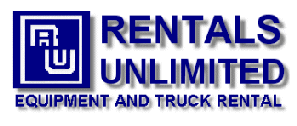 |
People have been unhappy with certain
characteristics of concrete floors for as
long as they have been around. They often
"dust", they are porous so they stain
easily, the plain gray color is flat and
unappealing, and they can wear from heavy
foot or vehicular traffic. Until recently,
the only way to address these problems was
to cover the concrete floor. Rugs, tile,
hardwood flooring, paint and epoxy have all
been used with varying degrees of success to
cover the concrete problems. The cost of
these toppings varies widely. The location
in the house partially determines what can
be used and what can't. For example, you
would not cover a garage floor with
carpeting or hardwood flooring. But people
have used paint or pigmented epoxy for years
to brighten the room, stop the dusting, and
make the floor easier to clean and harder to
stain. |
| |
|
 |
The problem with paint as a concrete
covering is that it quickly peels off and
requires yearly re-coating. Epoxy does
better, but it is a topping that can still
delaminate if moisture is coming up through
the floor. It is much like plastic; it can
scratch easily and melt if welding sparks
lay on it. |
| |
|
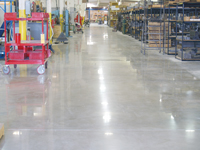 |
This is where concrete polishing fits in. It
gives all the benefits of a good epoxy
floor, but it does not have any of the
problems associated with coatings. Lighting
engineers say that the high shine and
reflectivity of a polished concrete floor
brighten a room by about 35% (considerably
more than an epoxy floor). There is no
coating that can fail; the floor still
breathes. The densifier that is added during
the polishing process chemically makes the
concrete surface much stronger and more
resistant to any wear. It also locks in the
dye that you can use to improve the
appearance of the floor. |
| |
|
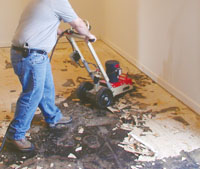 |
Even concrete floors that are covered with
things like linoleum or tile can be dyed and
polished after removing the covering. The
new floor will be easier to clean and more
durable than the old covering. |
| |
|
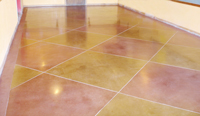 |
CONTRx polishing machines have also bridged
the gap between the small residential and
large commercial polished floors. The strip
mall is a perfect example. You will often
see medical offices within a strip mall type
setting. These offices will have many rooms
and narrow hallways dividing the floors into
small areas where larger industrial
polishers won't work. The CONTRx dual-disc
polisher works very efficiently in this
setting, and our single-disc polisher will
work in even the smallest of rooms or
closets. |
| |
|
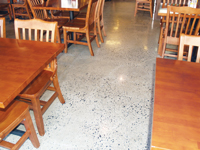 |
Restaurants and bars are using polished and
dyed concrete floors more all the time for
that "old world" look that is extremely easy
to clean. The artistic appearance achieved
from a polished and dyed floor lends itself
perfectly to specialty retail shops where
you often see interesting lighting and works
of art throughout. |
| |
|
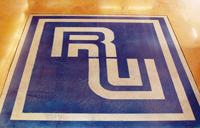 |
The entrance area to a commercial
establishment lends itself to logos or
unique designs that can be done with dyes
that are applied to the polished floor.
Through the polishing process, old worn
concrete can be rejuvenated to a new bright
and highly reflective floor that won't wear
like the original. |
